Table of Contents
Introduction
Network as a Service Statistics: Network as a Service (NaaS) revolutionizes networking by providing on-demand resource access without hefty infrastructure investments. Operating on a subscription model, NaaS adapts to diverse industry needs, offering flexibility and scalability.
Virtualized functions, software-defined networking, and cloud-based services are key components, providing organizations with enhanced control and agility.
NaaS, with features like bandwidth management and security protocols, enables efficient navigation of modern networking complexities.
Positioned as a strategic enabler amid digital transformation, NaaS facilitates rapid application deployment.
Cautious optimism surrounds NaaS, anticipating its potential to reshape networking infrastructures to meet the evolving demands of today’s interconnected business environment.
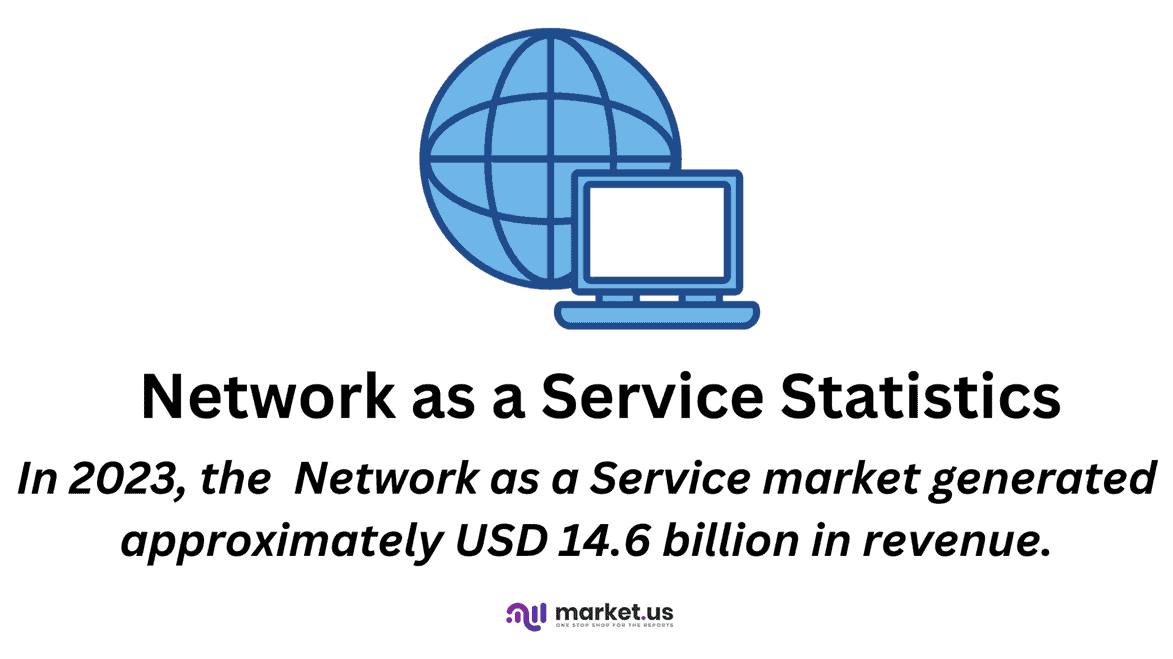
Editor’s Choice
- The revenue trend within the Network as a Service (NaaS) market showcases a consistent and robust growth trajectory at a CAGR of 26.7%.
- The NaaS market reached a revenue of 14.6 billion USD in 2023.
- In 2022, the total NaaS market revenue stands at 11.5 billion USD, comprising WAN-as-a-service revenue of 7.6 billion USD and LAN-as-a-service revenue of 3.9 billion USD.
- As of the latest data, large enterprises claim a substantial majority, holding a commanding market share of 55%.
- Among the contributing factors, networking-related outages emerge as the primary driver, accounting for 29% of the responses.
- In 2020, Huawei led the pack with a substantial market share of 26.9%. Solidifying its position as a key player in the networking landscape.
- Amazon Web Services (AWS) exhibited a consistent upward trajectory, starting at 67% adoption in 2019 and reaching 80% by 2022.
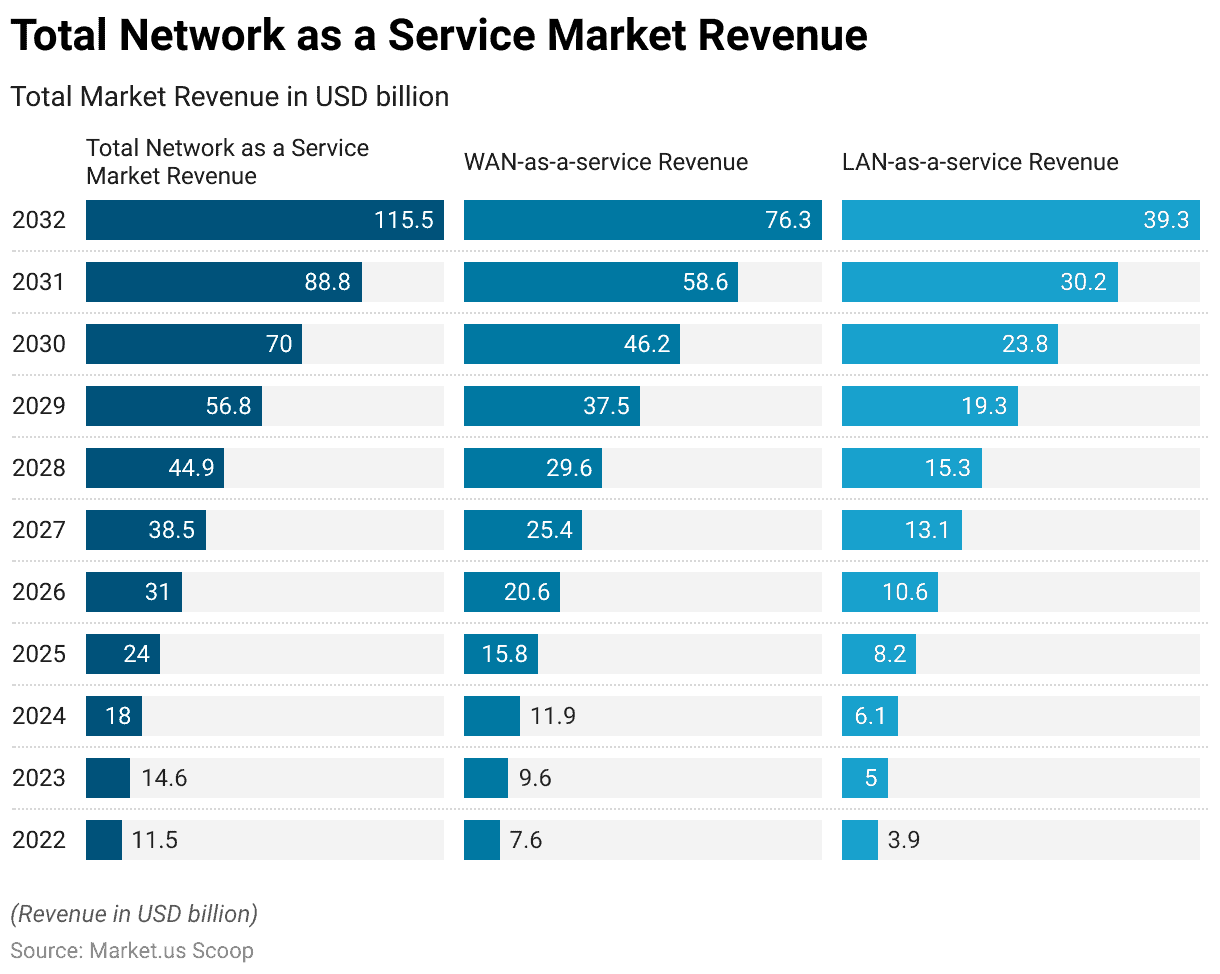
Network as a Service Market Statistics
Global Network as a Service Market Size Statistics
- The revenue trend within the Network as a Service (NaaS) market showcases a consistent and robust growth trajectory at a CAGR of 26.7% over the forecasted period from 2022 to 2032.
- Commencing at 11.5 billion USD in 2022, the market exhibits a steady escalation. Reaching 14.6 billion USD in 2023 and further expanding to 18.0 billion USD in 2024.
- The subsequent years witnessed substantial growth, with revenues climbing to 24.0 billion USD in 2025, 31.0 billion USD in 2026, and 38.5 billion USD in 2027.
- The momentum persists, leading to a revenue of 44.9 billion USD in 2028. Followed by notable jumps to 56.8 billion USD in 2029 and 70.0 billion USD in 2030.
- As we progress into the latter part of the forecast, the NaaS market continues its upward trajectory. Recording revenues of 88.8 billion USD in 2031 and a significant milestone of 115.5 billion USD in 2032.
- This consistent upward trend reflects the substantial demand and growth opportunities within the Network as a Service sector. Underlining its prominence in the evolving landscape of technological services.
(Source: Market.us)
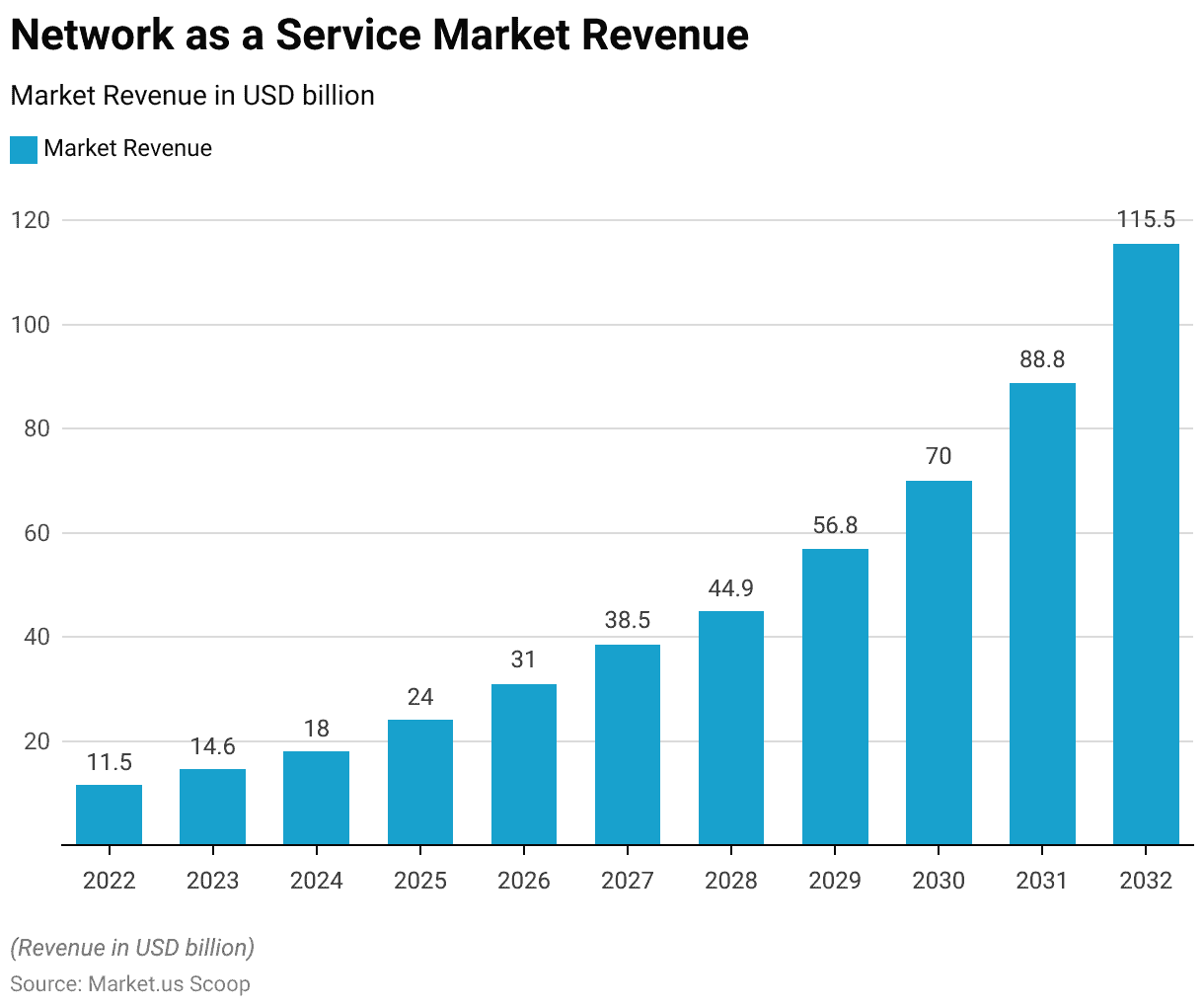
Network as a Service Market Size – By Type Statistics
- The Global Network as a Service (NaaS) market demonstrates a substantial and progressive expansion. Discerned by the evolving revenue figures across different types of services from 2022 to 2032.
- In 2022, the total NaaS market revenue stands at 11.5 billion USD. Comprising WAN-as-a-service revenue of 7.6 billion USD and LAN-as-a-service revenue of 3.9 billion USD.
- The subsequent years witnessed a consistent upward trajectory. With total market revenues reaching 14.6 billion USD in 2023, 18.0 billion USD in 2024, and 24.0 billion USD in 2025.
- This growth is mirrored in the WAN and LAN segments, emphasizing a parallel ascent.
- The trend continues with revenues escalating to 31.0 billion USD in 2026, 38.5 billion USD in 2027, and 44.9 billion USD in 2028.
- The differentiated revenues for WAN-as-a-service and LAN-as-a-service exhibit a similar pattern.
- As the market matures, substantial figures are evident. With total NaaS revenue reaching 56.8 billion USD in 2029, 70.0 billion USD in 2030, and 88.8 billion USD in 2031.
- The WAN-as-a-service and LAN-as-a-service segments similarly contribute to this upward trajectory.
- The pinnacle is achieved in 2032, with the total NaaS market soaring to 115.5 billion USD. Driven by WAN-as-a-service revenue of 76.3 billion USD and LAN-as-a-service revenue of 39.3 billion USD.
- This comprehensive growth narrative underscores the increasing significance and demand for diverse Network as a Service offering across the global landscapes.
(Source: Market.us)

Network as a Service Market Share – By Enterprise Size Statistics
- The Global Network as a Service (NaaS) market exhibits a distribution of market share delineated by enterprise size, with a discernible dominance by large enterprises.
- As of the latest data, large enterprises claim a substantial majority, holding a commanding market share of 55%.
- In tandem, small and medium-sized enterprises (SMEs) contribute significantly, securing 45% of the market share.
- This distribution underscores the prominence of large enterprises as key players in the NaaS landscape. Emphasizing their substantial influence and market presence.
- The balance between large enterprises and SMEs highlights the diverse participation and impact of businesses of varying sizes within the dynamic realm of Network as a Service.
(Source: Market.us)
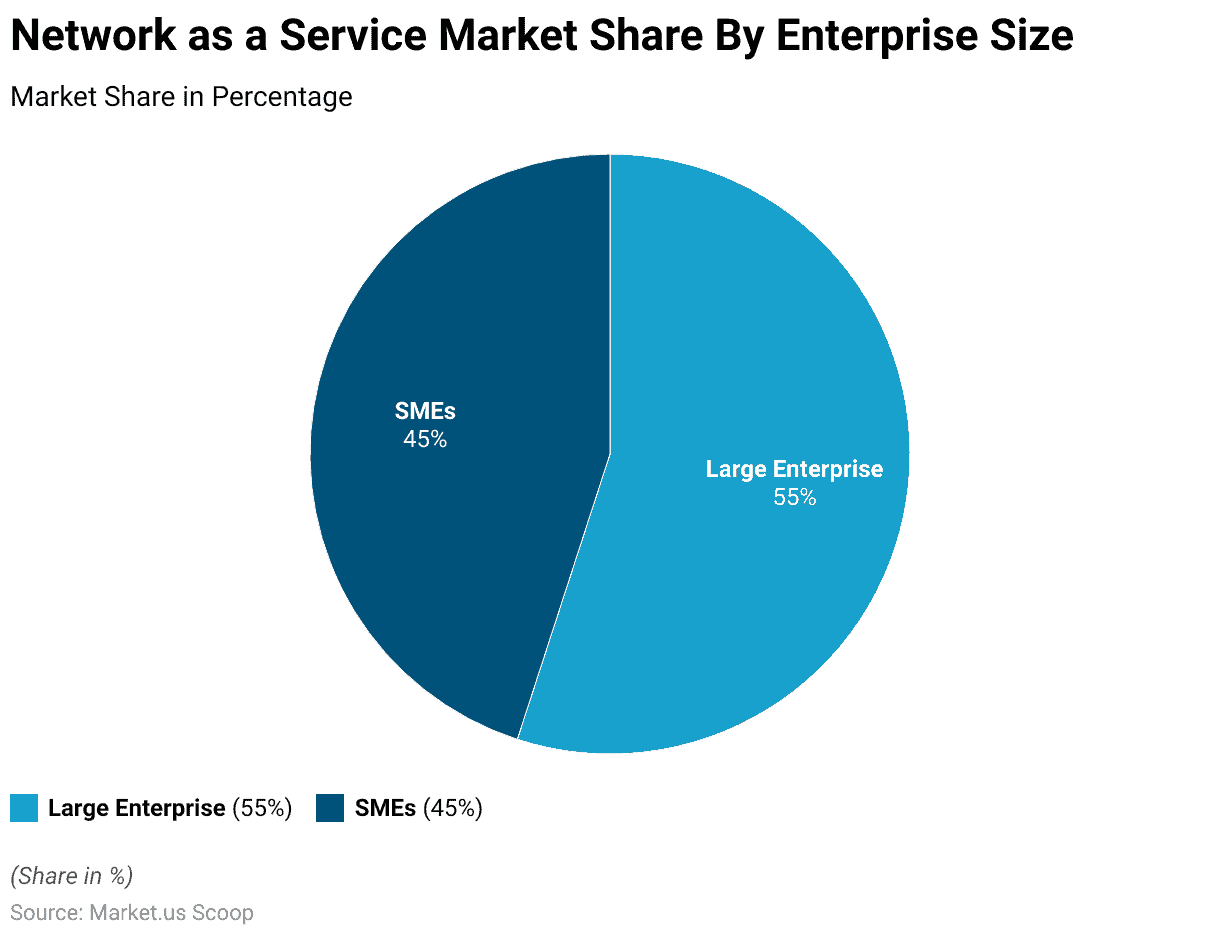
Factors Driving the Demand for NaaS
- The demand for Network as a Service (NaaS) is propelled by a variety of factors. IT service outages play a pivotal role in shaping this demand landscape.
- Among the contributing factors, networking-related outages emerge as the primary driver, accounting for 29% of the responses.
- Power-related outages closely follow, constituting 25% of the factors influencing the demand for NaaS.
- Notably, a significant portion of respondents, totaling 24%, attribute the impetus for NaaS adoption to a lack of IT service outages over the past three years. Indicating a proactive approach to maintaining uninterrupted services.
- Third-party IT service-related outages, such as those associated with public cloud services or software as a service, contribute to 16% of the demand drivers.
- Additionally, other miscellaneous factors contribute to 7% of the responses.
- This nuanced understanding of the factors driving NaaS demand reflects the diverse challenges and considerations that organizations weigh in their quest for robust and resilient IT infrastructure.
(Source: Uptime Institute Survey)
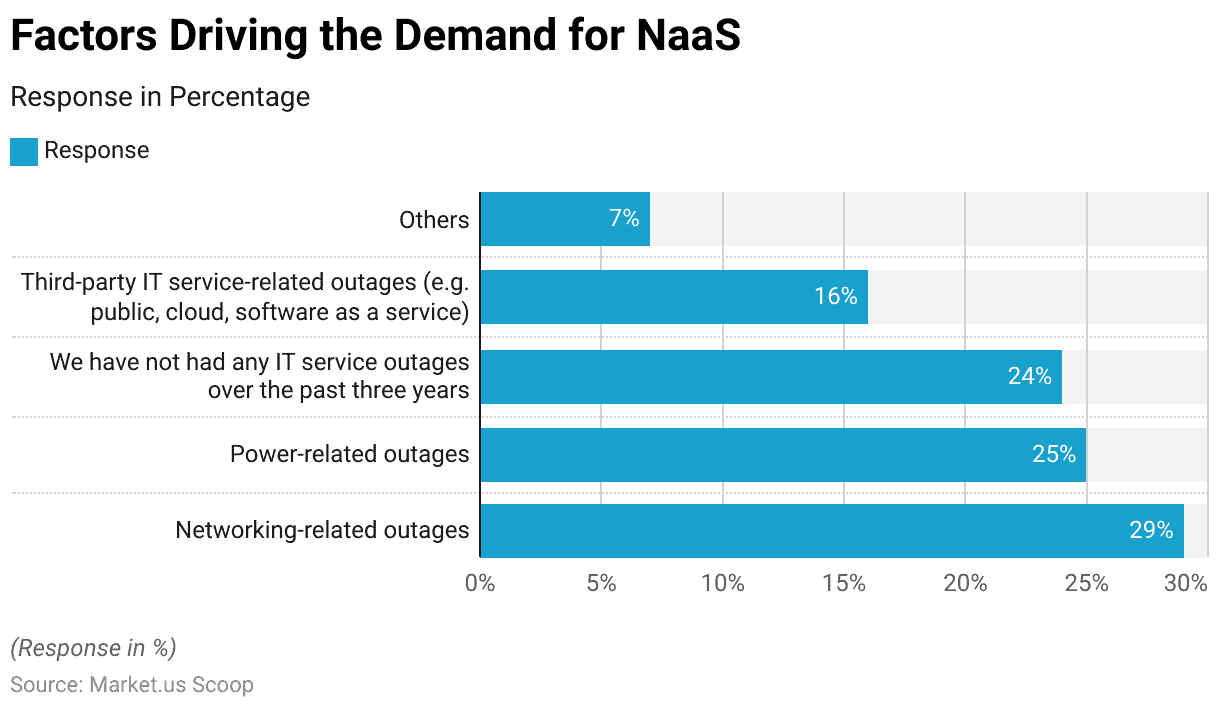
Common Root Causes for Networking-related Outages
- Networking-related outages in the IT landscape can be attributed to various root causes, as identified by respondents.
- The most prevalent root cause, cited by 49% of respondents, is configuration/change management failure. Underlining the critical importance of effective management in maintaining network stability.
- Third-party network provider failure follows closely, with 39% of responses indicating its impact on networking-related outages.
- Firmware/software errors contribute significantly, accounting for 31% of the root causes, emphasizing the need for robust software management practices.
- Natural disasters, such as public works or line breakages, are identified as a root cause by 26% of respondents. While network overload or congestion issues contribute to 24% of the responses. Corrupted firewall rules and routing table issues are noted as a cause by 17% of respondents.
- Malicious cyber-attacks, including Distributed Denial of Service (DDoS) and network partitioning. Constitute 16% of the root causes, highlighting the persistent threat landscape.
- Interestingly, a notable 9% of respondents claim not to have experienced networking-related IT outages due to hardware failure.
- A small percentage (7%) express uncertainty about the root cause and 1% attribute networking-related outages to other unspecified factors.
- This comprehensive overview delineates the multifaceted nature of root causes behind networking-related outages, underscoring the need for comprehensive strategies to mitigate and address these challenges in the IT infrastructure.
(Source: Uptime Institute Survey)
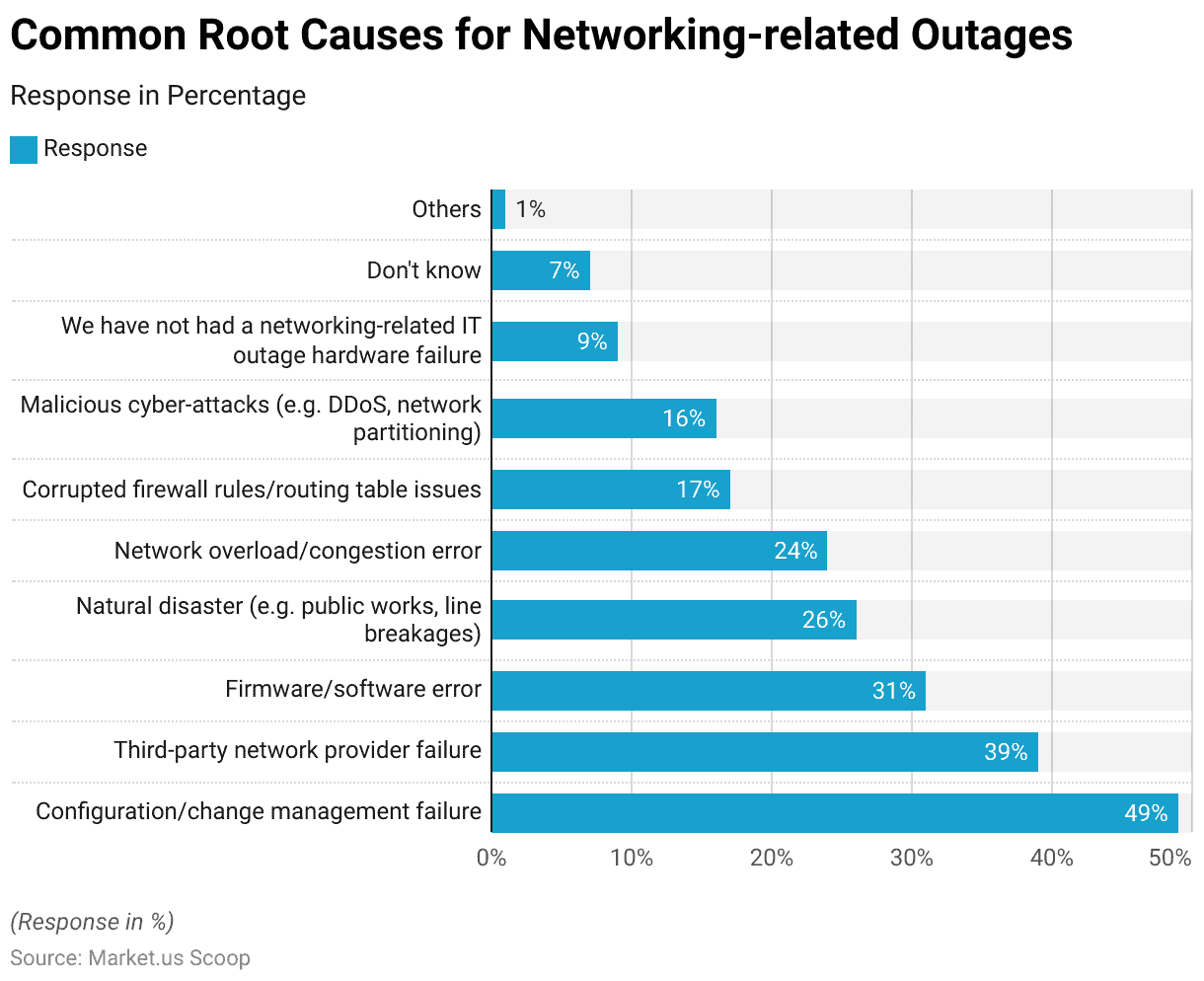
Most Important Network Infrastructure Providers
- In 2020, the market share among network providers was characterized by a prominent presence of industry leaders.
- Huawei led the pack with a substantial market share of 26.9%, solidifying its position as a key player in the networking landscape.
- Following closely behind, Cisco secured a notable 15.1% market share, showcasing its influence in the industry.
- Nokia and Ericsson, with market shares of 11.4% and 9.6%, respectively, maintained significant positions, contributing to the competitive dynamics of the market.
- ZTE, with a 5.9% market share, and NEC, with 3.2%, represented additional contributors to the network provider landscape.
- Motorola Solutions, holding a 2.6% market share, rounded out the key players in this competitive field.
- These percentages delineate the distribution of market influence among the major network providers, highlighting the diverse landscape and the distinct market positions occupied by each company in 2020.
(Source: Statista)
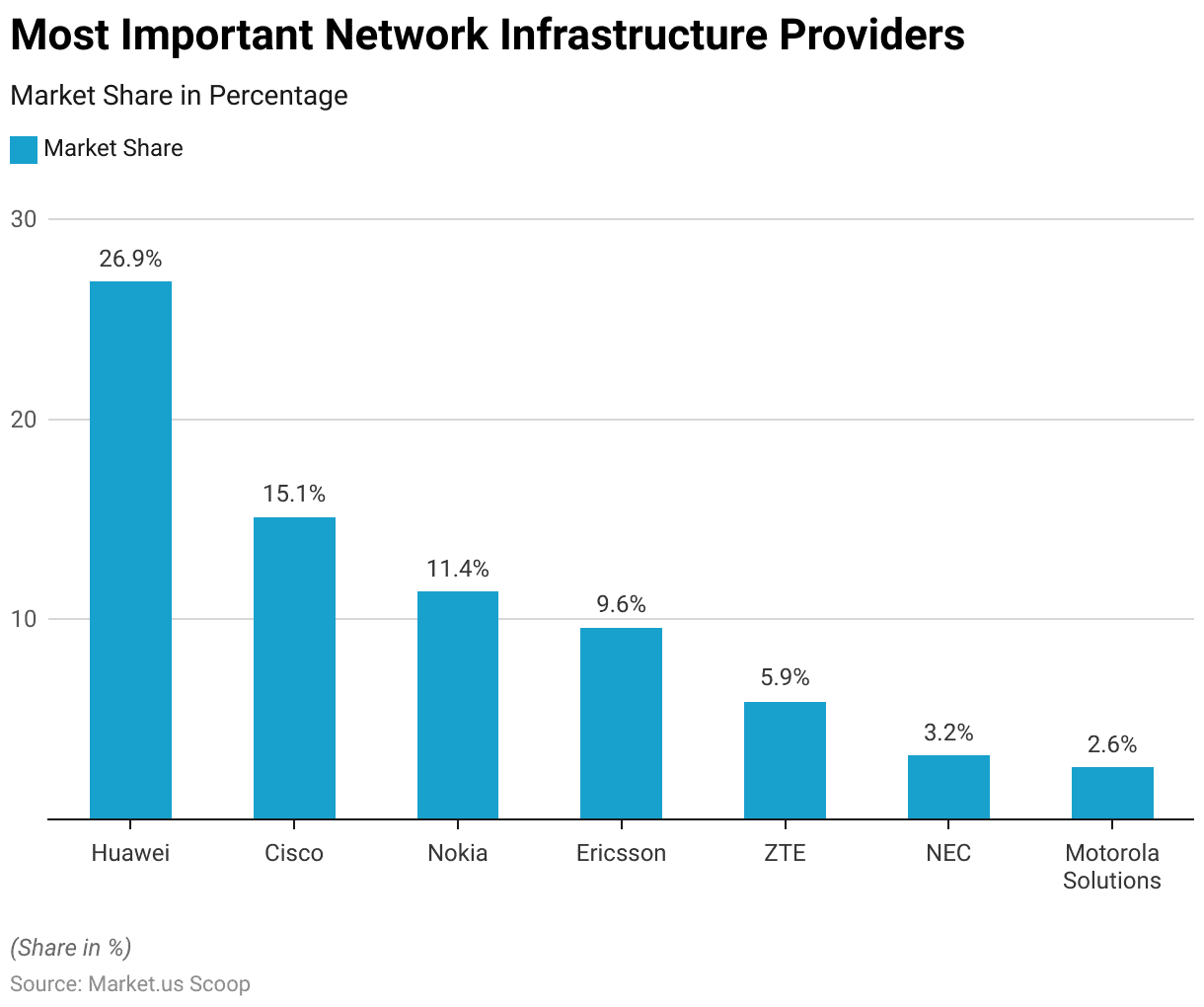
Adoption of Public Cloud Services by Enterprises
- The adoption of public cloud services by enterprise providers witnessed notable shifts from 2019 to 2022, reflecting the evolving dynamics in the cloud computing landscape.
- Amazon Web Services (AWS) exhibited a consistent upward trajectory, starting at 67% adoption in 2019 and reaching 80% by 2022.
- Microsoft’s Azure also demonstrated substantial growth, from 69% in 2019 to an equal 80% adoption rate in 2022.
- Google Cloud experienced remarkable expansion, jumping from 20% in 2019 to 48% in 2022, showcasing its increasing appeal among enterprises.
- Oracle Infrastructure Cloud saw fluctuations, with a peak adoption of 32% in 2021, while IBM Public Cloud maintained a steady presence, holding a 25% adoption rate in 2022.
- Although starting at 4% in 2019, Alibaba Cloud demonstrated consistent growth, reaching an 11% adoption rate in 2022.
- These trends underscore the dynamic nature of cloud service adoption, with AWS and Azure maintaining dominance, while other providers experience varying degrees of success in capturing market share.
- The figures highlight the competitive landscape of public cloud services and the strategic choices made by enterprises in aligning with different cloud platforms over this period.
(Source: Flexera Software)
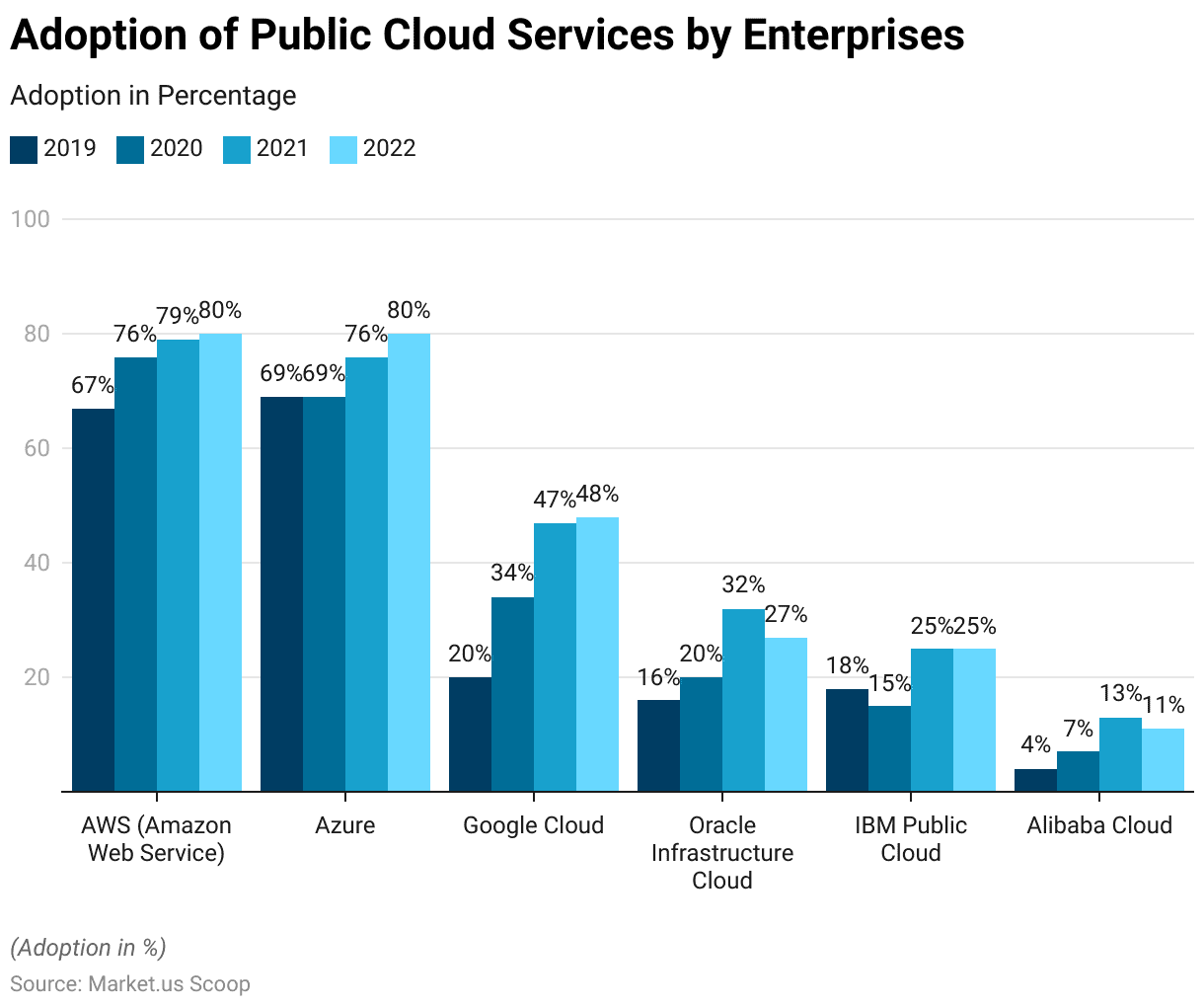
Network as a Service Challenge Statistics
- A mere 48% of professionals acknowledge regularly staying connected with their network, while 38% express the difficulty of maintaining such connections, primarily attributing it to a shortage of time.
- The desire to network more frequently is shared by 41% of individuals.
- Notably, the challenges in keeping in touch could be a factor in this aspiration, as reflected in the similar percentage of those wishing for more networking opportunities.
- The COVID-19 pandemic has contributed to a staggering 600% surge in cybercrime, posing a substantial drawback to online networking.
- The prevalence of hacking, phishing, scams, and related issues poses significant hurdles to effective networking.
- Moreover, ensuring cybersecurity for extensive networking teams can become a substantial and costly undertaking.
(Source: Zippia)
Post-pandemic NaaS Trends
- The demand for IT agility and efficient network procurement and management has intensified amid post-pandemic trends.
- IT procurement cycles have quickened, and investments have seen a more significant uptick compared to the pre-COVID era.
- As per an IDC InfoBrief, 71% of organizations note a reduction in their long-term planning cycles due to the impact of COVID-19.
- Furthermore, 82% of these organizations specify that their long-term planning cycles are now restricted to two years or less.
- Given the prevalence of hybrid work environments, there is a heightened emphasis on securing the enterprise both within and beyond its traditional boundaries in a manner that is both flexible and scalable.
- To meet this demand and ensure uninterrupted connectivity, organizations are swiftly embracing consumption-driven Network as a Service (NaaS) models.
- This approach allows them to align the costs of network expansion with the digital experience of their stakeholders.
(Source: IDC InfoBrief)
Recent Developments
Acquisitions and Mergers:
- Cisco acquires Viptela: In 2023, Cisco completed the acquisition of Viptela, a leading provider of cloud-based SD-WAN solutions, for $610 million. This acquisition aims to strengthen Cisco’s NaaS offerings by integrating Viptela’s scalable network technology for enterprise clients.
- HPE (Aruba) acquires Silver Peak: In 2023, Hewlett Packard Enterprise (HPE) acquired Silver Peak, an SD-WAN specialist, for $925 million. This acquisition boosts HPE’s edge services and enhances its NaaS solutions by improving network management capabilities across hybrid cloud environments.
New Product Launches:
- Verizon introduces the NaaS platform: In early 2024, Verizon launched its NaaS platform targeting businesses of all sizes. The platform provides scalable network solutions with integrated security features, allowing companies to easily access cloud-managed networking and edge computing.
- AT&T unveils 5G NaaS solution: In March 2024, AT&T launched its 5G-powered NaaS solution, designed to provide ultra-low-latency connectivity for enterprise IoT and edge computing. The service is expected to drive adoption in industries like manufacturing and smart cities.
Funding:
- Aryaka raises $50 million for NaaS expansion: In 2023, Aryaka Networks, a key player in cloud-first WAN and security, secured $50 million in a funding round to expand its NaaS offerings globally. This funding will help the company scale its solutions and improve enterprise network management capabilities.
- Cato Networks secures $77 million in Series E funding: In 2024, Cato Networks raised $77 million to grow its NaaS platform, which integrates networking and security as a unified service. This investment supports the company’s plan to enhance its NaaS infrastructure and expand in key markets.
Technological Advancements:
- AI and automation in NaaS: By 2025, 45% of NaaS providers are expected to incorporate AI-driven automation to enhance network performance, reduce downtime, and provide predictive maintenance for clients. This trend is set to revolutionize network management.
- Integration of 5G in NaaS platforms: With the growth of 5G, 30% of NaaS solutions are projected to integrate 5G capabilities by 2026, enabling ultra-fast network speeds and supporting real-time data processing in edge computing and IoT applications.
Conclusion
Network as a Service Statistics – In summary, Network as a Service (NaaS) is a game-changer in networking, ushering in a shift from traditional hardware-centric models to more flexible and scalable solutions.
The market’s upward trajectory, reflected in robust revenue projections, underscores its growing importance for businesses seeking cost-effective infrastructure.
Despite challenges like security concerns and interoperability issues, NaaS’s positive trajectory, supported by real-world success stories, instills confidence in its potential. Looking forward, integrating NaaS with edge computing and its role in the IoT ecosystem promises further innovation.
NaaS is not just a glimpse into the future but a transformative force actively shaping the networking landscape for businesses aiming at adaptability and efficiency in a dynamic market.
FAQs
NaaS is a networking model that provides on-demand network functionality through cloud-based services. It allows users to access and use network resources without the need for extensive infrastructure investments.
Unlike traditional networking, NaaS is based on virtualization and cloud computing, offering more flexibility and scalability. It allows users to tailor network services to their specific needs, promoting efficiency.
NaaS leverages virtualization, incorporating Network Function Virtualization (NFV) and Software-Defined Networking (SDN). These components enable centralized control, programmability, and efficient resource allocation.
NaaS provides flexibility, scalability, and cost efficiency. It enables rapid deployment of network services, aligning with dynamic business needs. The pay-as-you-go model reduces capital expenditure for organizations.
Post-pandemic, the need for IT agility has accelerated NaaS adoption. Organizations are leveraging NaaS models to balance the cost of network growth with the digital experience of stakeholders in hybrid work environments.
Discuss your needs with our analyst
Please share your requirements with more details so our analyst can check if they can solve your problem(s)



